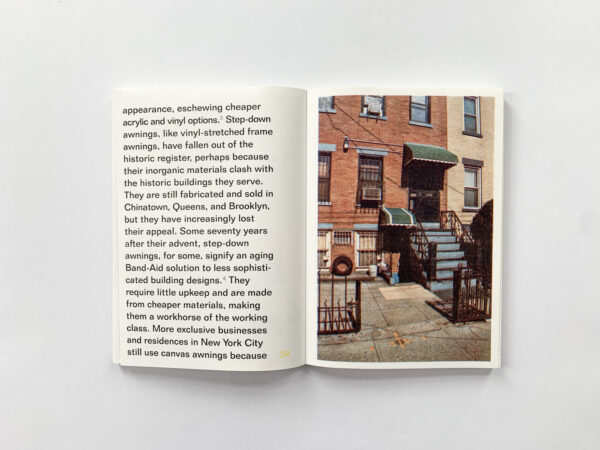Awnings
Awnings
This book is an experience of a guided tour through New York discovering the many functions of awnings as objects in the streets. Clearly, the designer of this book has worked from an obsession with the origin and look of the awnings, a vernacular object that often goes unnoticed. The choice of using full color Risograph printing creates a nostalgic vibe, it almost implies we are in another era which matches with long history of the object and its functional solution throughout history. The choice of varying layouts makes flipping through the book exciting despite significant similarities between the photographs of houses with awnings. The unusual Japanese binding, although determined by practicality for production recalls the folded fabric of awnings. The accompanying essay elaborates on the subject and the large typography also mimics the frequently recurring striped pattern. It is a good reminder that anything can become interesting if we give it enough attention. The combination of the mundane yet completely distinctive topic of awnings combined with the spot-on choice of exclusive four color RISO production resulted in our decision to select it for The Best Dutch Book Designs. The full color RISO imparts an uncanny beauty to the images and creates an illusion of stripes and moving imagery which fits conceptually the visual characteristics of the subject matter. This is enhanced further still by the fact that, like an awning, you simply fold the book in or out physically. The Japanese binding results in thick and tangible pages while at the same time provides a solution for ink not leaking through the paper.
- Auteur
- Sean Kuhnke, Jordan Hruska
- Oplage
- 100
- Omvang
- 68
- Prijs
- €65
- ISBN
- 978 1 7321069 0 1
- Uitgever / Opdrachtgever
- Jan van Eyck Academie, Maastricht
- Ontwerper(s)
- Sean Kuhnke, Maastricht
- Fotograaf
- Sean Kuhnke
- Drukkerij
- Jo Frenken, Sean Kuhnke, Maastricht
- Lithograaf
- Sean Kuhnke, Maastricht
- Boekbinderij
- Jo Frenken, Sean Kuhnke (Charles Nypels Lab Jan van Eyck Academie, Maastricht), spine is screen-printed in black
- Materiaal
- 80gsm EOS 2.0 (Igepa)
- Bindwijze
- Bound in Japanese style, spine covered with self-adhesive linen in several colours (Filmoplast T, supplied by Schmedt)
- Lettertype
- Commencement (Jangs Müller Type Foundry), Folio (Bauer Foundry)
This book is an experience of a guided tour through New York discovering the many functions of awnings as objects in the streets. Clearly, the designer of this book has worked from an obsession with the origin and look of the awnings, a vernacular object that often goes unnoticed. The choice of using full color Risograph printing creates a nostalgic vibe, it almost implies we are in another era which matches with long history of the object and its functional solution throughout history. The choice of varying layouts makes flipping through the book exciting despite significant similarities between the photographs of houses with awnings. The unusual Japanese binding, although determined by practicality for production recalls the folded fabric of awnings. The accompanying essay elaborates on the subject and the large typography also mimics the frequently recurring striped pattern. It is a good reminder that anything can become interesting if we give it enough attention. The combination of the mundane yet completely distinctive topic of awnings combined with the spot-on choice of exclusive four color RISO production resulted in our decision to select it for The Best Dutch Book Designs. The full color RISO imparts an uncanny beauty to the images and creates an illusion of stripes and moving imagery which fits conceptually the visual characteristics of the subject matter. This is enhanced further still by the fact that, like an awning, you simply fold the book in or out physically. The Japanese binding results in thick and tangible pages while at the same time provides a solution for ink not leaking through the paper.
- Auteur
- Sean Kuhnke, Jordan Hruska
- Oplage
- 100
- Omvang
- 68
- Prijs
- €65
- ISBN
- 978 1 7321069 0 1
- Uitgever / Opdrachtgever
- Jan van Eyck Academie, Maastricht
- Ontwerper(s)
- Sean Kuhnke, Maastricht
- Fotograaf
- Sean Kuhnke
- Drukkerij
- Jo Frenken, Sean Kuhnke, Maastricht
- Lithograaf
- Sean Kuhnke, Maastricht
- Boekbinderij
- Jo Frenken, Sean Kuhnke (Charles Nypels Lab Jan van Eyck Academie, Maastricht), spine is screen-printed in black
- Materiaal
- 80gsm EOS 2.0 (Igepa)
- Bindwijze
- Bound in Japanese style, spine covered with self-adhesive linen in several colours (Filmoplast T, supplied by Schmedt)
- Lettertype
- Commencement (Jangs Müller Type Foundry), Folio (Bauer Foundry)



